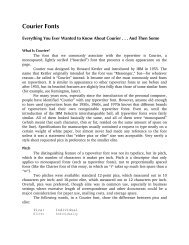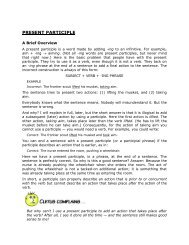Ellipsis - Roland Stroud
Ellipsis - Roland Stroud
Ellipsis - Roland Stroud
You also want an ePaper? Increase the reach of your titles
YUMPU automatically turns print PDFs into web optimized ePapers that Google loves.
CONSISTENCY<br />
1.1.8 It is proper style to use the same method for representing ellipsis throughout the entirety of a<br />
work. It is not unusual to find lackadaisical writing with improperly placed groups of three or<br />
four dots, with no consistency whatever.<br />
SPACING OF DOTS<br />
1.1.9 The spacing of the dots is important. Although it is common for writers to place the dots<br />
together with no spaces between them, such practice is generally unacceptable. As a rule, there<br />
should always be a space between any two dots, as well as between a dot and any other<br />
adjacent mark of punctuation. (See ELLIPSIS IN PLAYS & SCREENPLAYS, below, for the exception<br />
when using a monospaced font.)<br />
ELLIPSIS IN PLAYS & SCREENPLAYS<br />
1.1.10 Exception to the rule. Dialogue lines in screenplays are very short (3-3½ inches). The standard<br />
font is monospaced Courier. <strong>Ellipsis</strong> dots with spaces gobble up a good deal of line length in a<br />
monospaced font that gives only ten characters per inch. Over a script of 115 pages, this lost<br />
space can add up. Moreover, word wrap in screenwriting software is not as sophisticated and<br />
customizable, at present, as in word processors. Dots may become separated at the end of a line<br />
when the line wraps. For these reasons it is better to omit the spaces between the dots.<br />
Obviously, this is an exception to the principles laboriously outlined above.<br />
1.1.11 The current practice of handling ellipsis in screenplays appears to follow the whim of each<br />
writer. Nonetheless, it is possible to offer some guidelines which are a rational application and<br />
modification of the general principles already presented.<br />
1.1.12 Four-dot method. Use of four-dot ellipsis (or ‘?’ or ‘!’, plus three dots) at the end of a<br />
grammatically complete unit, and three dots to link within the same sentence, is the most logical<br />
method. In the next example the ‘. . . .’ after today signals an end of the sentence and a pause<br />
or sudden change. The ‘? . . .’ after wrong is likewise the end of a sentence and the start of a<br />
break. The first dot (or ‘?’ or ‘!’) is printed up close to the preceding word. The ‘. . .’ between<br />
just and tell connects two fragments and has spaces before and after the group, since Please,<br />
just is not a complete sentence.<br />
Excellent form:<br />
HANK<br />
You look strange today.... What’s<br />
wrong?... Please, just ... tell me.<br />
1.1.13 Three-dot method. Many writers cannot distinguish easily between text that is grammatically<br />
complete and text that is fragmentary. Fortunately, three-dot ellipsis, which is an acceptable<br />
method, keeps everything simple. As long as the dot group is preceded and followed by a space,<br />
three dots can connect a sentence to a sentence, a sentence to a fragment, or a fragment to a<br />
fragment. Although writers commonly use the three dots, they frequently fail to set the dot<br />
group off with spaces. It is noteworthy that formatting properly by adding spaces can actually<br />
save line space sometimes and sometimes result in fewer lines, because the spaces before and<br />
after the dot group allow better word wrap. The following examples illustrate this.<br />
3




